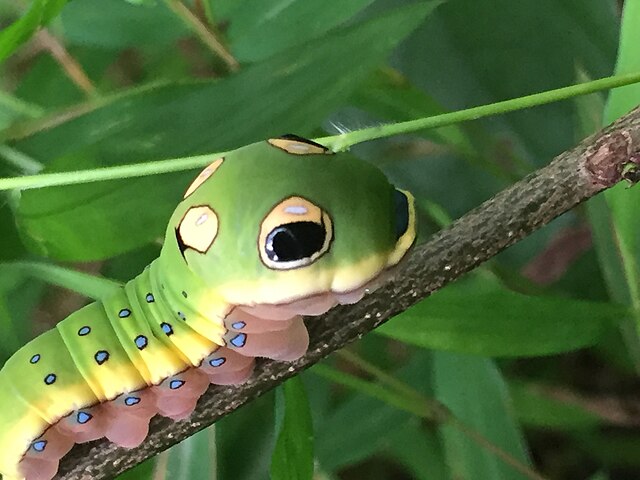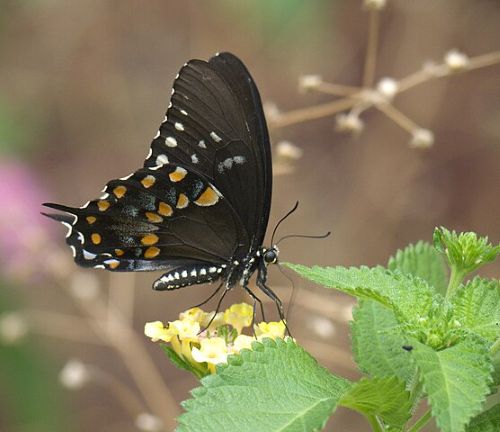Eye spots are effective only from a refuge
The eyespots of a spicebush swallowtail caterpillar protect the animal from hungry birds – but only when the caterpillar is concealed, Elizabeth Postema shows.
An older caterpillar of the spicebush swallowtail butterfly Papilio troilus has an appealing swollen head with two eyespots. It is obvious that these eyespots serve to deter predators. But they do so only under special conditions, Elizabeth Postema writes.
The swallowtail occurs in North America; the caterpillars live on leaves of trees and shrubs such as sassafras and American tulip tree. A common predator of caterpillars is the black-capped chickadee (Poecile atricapillus), a tit species.
Frightening
A spicebush swallowtail caterpillar sitting openly on a leaf is visible; it is green, but in a slightly different shade than the leaf. The eye spots make it even more conspicuous. That is why a caterpillar hides during the day to escape detection by hungry tits and other predators. Lying on the midrib of a leaf with its head turned towards the tip, it exudes silk. The silk dries and shrinks, forcing the leaf to fold around the caterpillar.
But what is the use of eyespots to a hidden caterpillar? Postema assumed that these eyespots are important when a bird peers into a leaf roll or picks it open. It will then suddenly see a snout with two eyes – an imitation of a snake – and be startled by it. Two eyespots that suddenly appear, the idea is, have a completely different effect than two eyespots that are continuously visible from far away.
Caterpillars of modelling clay
She tested this hypothesis with artificial caterpillars. She made hundreds of green caterpillars of modelling clay with and without eyespots and attached them to tree leaves, which she then folded around the caterpillar or not. So, there were four experimental groups: visible caterpillar without eyespots, visible caterpillar with eyespots, hidden caterpillar without eyespots and hidden caterpillar with eyespots. After five days, she looked for her artificial caterpillars and checked whether they showed bite marks from birds.
As expected, she discovered that a leaf roll offers protection. Caterpillars that were sitting on a leaf in the open were attacked more often than caterpillars that were hidden.
Eye spots did not help the visible caterpillars: tits did not care. But caterpillars in a leaf roll – which were already safer – were even better off with eyespots. Eye spots made the chance of an attack smaller. Postema’s assumption appears to be correct.
The conclusion is that spicebush swallowtail caterpillars protect themselves by combining eyespots with a refuge, so that the ‘eyes’ suddenly pop out in the event of acute danger.
Young caterpillars have no eyespots, but use a different defense strategy: predators overlook them because they are brown and resemble bird droppings.
Willy van Strien
Photo:
Large: caterpillar of spicebush swallowtail Papilio troilus. NCBioTeacher (Wikimedia Commons, Creative Commons, Public Domain)
Small: adult spicebush swallowtail. Robert Webster (Wikimedia Commons, Creative Commons CC BY-SA 4.0)
Source:
Postema, E.G., 2024. Eyespot peek-a-boo: Leaf rolls enhance the antipredator effect of insect eyespots. Journal of Animal Ecology, online December 25. Doi: 10.1111/1365-2656.14232

